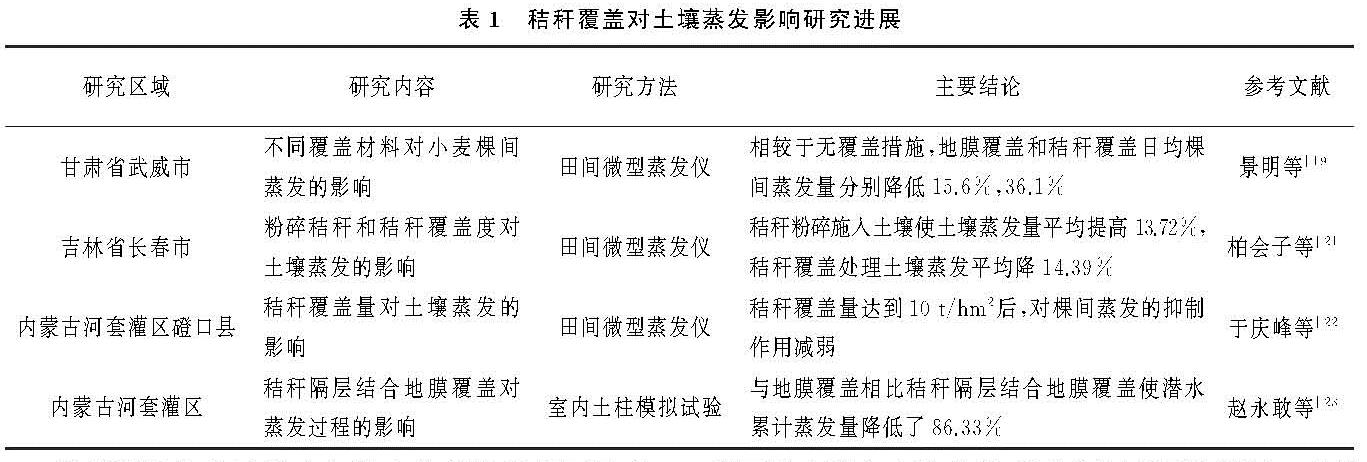水土流失这一全球性资源与环境问题,是生态环境退化的反映,也是导致生态环境进一步恶化的原因。雨滴溅蚀通常被认为是坡面水力侵蚀的最初阶段[40],该过程使土壤表层结构破碎,堵塞土壤孔隙,抑制土壤入渗作用,促进径流的产生,为面蚀和沟蚀发生提供条件,是侵蚀发生发展过程中不容忽视的一个阶段。面蚀、沟蚀发生在雨滴击溅侵蚀之后,是水力侵蚀破坏土壤资源,造成土地退化的主要发生方式。秸秆覆盖可增加地表覆盖度,拦截降雨,调节地表径流[30],提高团聚体稳定性,以提高土壤抗侵蚀能力[36],是坡耕地土壤侵蚀防治的有效措施。明晰秸秆覆盖下雨滴溅蚀、面蚀及沟蚀发生过程和特点,是准确掌握和预测侵蚀发生发展过程、有效布置防治措施的基础。
3.1 秸秆覆盖对雨滴溅蚀的影响
雨滴溅蚀是坡面水力侵蚀的最初阶段,常发生于裸露地表,过程中土壤结构破碎,细颗粒堵塞土壤孔隙,抑制土壤入渗作用,促进面蚀和沟蚀的发生和发展[40]。在一定径流水深条件下,溅蚀作用还可以增大坡面径流紊动性,增强径流携沙能力[41]。此外,溅蚀会造成土壤板结,影响作物出苗率。秸秆覆盖对雨滴溅蚀的抑制作用主要体现在两个方面:(1)研究发现雨滴溅蚀率与降雨动能呈显著正相关,秸秆覆盖于地表改变了雨滴击溅的直接作用对象,削弱了降雨动能,从而减少溅蚀的发生[42]。(2)秸秆还田提高土壤有机质含量,促进良好团聚体的形成[36],并增强其稳定性,减弱了土壤对雨滴机械打击和消散作用的敏感程度,增强了土壤抗侵蚀能力[43]。Kukal等[44]通过人工模拟降雨探究了秸秆覆盖对雨滴溅蚀和降雨入渗的影响,结果表明:与不覆盖处理相比,秸秆覆盖减少了68%的溅蚀量,土壤入渗率比无覆盖处理高54%。
3.2 秸秆覆盖对面蚀的影响
面蚀与沟蚀是水力侵蚀造成土壤流失、土地退化和面源污染的主要发生方式,因此是坡面水力侵蚀防治的重点。地表径流是水土流失的主要驱动力,秸秆覆盖主要通过:(1)促进降雨入渗,减少径流产生;(2)增加地表糙度,影响径流流速和径流剪切力等水力学特征[45],从而影响坡耕地土壤侵蚀发生发展。李飞等[46]研究表明天然降雨条件下秸秆覆盖相对常规模式可使东北坡耕地土壤径流量减少94.03%~97.97%,土壤流失量减少90.21%~97.39%。王安等[47]通过人工模拟降雨试验,研究了秸秆覆盖对黄土坡面土壤侵蚀的影响,结果显示秸秆覆盖最高可减少75%的土壤侵蚀量,若结合高留茬,对土壤侵蚀的抑制作用会更强。白永会等[32]采用模拟降雨试验的方法,开展了秸秆覆盖对红壤水土流失防控效益和径流剪切力影响的研究,发现秸秆覆盖减流效益达到69.3%,减沙效益达到99.2%,秸秆覆盖和未覆盖的临界启动径流剪切力分别为2.8,1.5 N/m2。可见针对不同的土壤和气候类型,秸秆覆盖均具备很好的防蚀效果。
人工模拟降雨方法可不受时间地点限制,可开展不同处理措施对坡面侵蚀的影响研究,受到研究者的青睐。车明轩等[48]通过室内人工模拟降雨,探究了紫土坡面秸秆覆盖水土保持作用的影响因素,发现雨强是影响秸秆覆盖保持水土作用的重要因子,与覆盖保水保沙率呈极显著负相关。也有研究[49-50]认为除雨强外坡度也影响着秸秆覆盖水土保持效果,在陡坡或强降雨(≥100 mm/h)条件下,秸秆覆盖反而会加剧土壤侵蚀。唐泽军[50]发现,当降雨强度达到100 mm/h时,在较小的坡度上,覆盖坡面土壤流失量与裸土坡面大致相当,而在较大坡度上,覆盖坡面的土壤流失量大于裸土坡度; 当降雨强度达到150 mm/h时,覆盖坡面的土壤流失量在试验设置坡度上均大于裸土坡面。庄晓晖[51]利用人工模拟降雨,研究了强降雨秸秆覆盖下受犁底层影响的黄土坡耕地产流产沙特征,结果表明,秸秆覆盖在降雨初期促进降雨入渗、延迟了产流起始时间,使耕作层很快饱和。但由于犁底层入渗率低,在强降雨条件下,秸秆覆盖坡面的土壤入渗率在产流之后快速降低,很快达到最小稳定入渗率,最终使得坡面径流量远大于未受到犁底层影响的裸土地面,加剧了侵蚀的发生。可见秸秆覆盖只有在特定的条件下才具备防蚀效果,而在极端降雨条件、陡坡或犁低层存在的情况下反而会加剧侵蚀。
秸秆覆盖的水土保持效果也受覆盖度和覆盖量的影响。杨青森等[52]通过野外原位人工模拟降雨试验,开展了秸秆不同覆盖量对东北黑土区土壤侵蚀影响研究,发现20 t/hm2的覆盖处理下坡面径流量、产沙量分别减少87%,99.86%,而40 t/hm2的秸秆覆盖处理下坡面无产流。张翼夫等[53]研究了玉米秸秆覆盖对华北地区农田土壤侵蚀的影响,研究结果显示秸秆覆盖具有很好的水土保持作用,在沙土地的效果优于壤土,30%~60%是水土保持效果和播种效果最佳的秸秆覆盖度。刘柳松等[54-55]则认为30%是红壤地区较为经济且水土保持效果好的秸秆覆盖度。唐涛等[56]采用人工模拟降雨试验,研究了秸秆不同覆盖度对西北干旱地区土壤侵蚀的影响,结果表明在覆盖率大于40%条件下水土流失能够得到有效控制,但当覆盖度低于40%时,秸秆覆盖对水土流失的作用不明显。由此可见最佳秸秆覆盖度的空间变异性很大,探索适合特定地区的秸秆覆盖度和覆盖方式,对提高土地生产力,保护生态环境具有重要意义。
3.3 秸秆覆盖对沟蚀和风蚀的影响
坡面水蚀从面蚀过渡到沟蚀后,径流深度、流速及侵蚀力的增加,使土壤颗粒大量损失,严重影响土地生产力和可持续发展能力。秸秆覆盖可通过减小坡面径流的流速,减弱径流挟沙能力以及侵蚀力,从而达到了减少坡面侵蚀量的目的,是沟蚀发展的重要防治措施[57]。徐锡蒙等[57]研究认为,秸秆覆盖可有效减少黄土区细沟和浅沟土壤侵蚀量,且玉米秸秆缓冲带覆盖可有效抑制沟头前进,是减少该区土壤侵蚀的有效覆盖方式。覃超等[58]认为在斜坡长4.5~7.5 m处布设玉米秸秆缓冲带防治侵蚀的效果较好。
在干旱半干旱区,风力侵蚀也是降低坡耕地土壤质量的一个重要因素,秸秆可以保护地表,避免风对地表土壤的直接作用。于爱忠等[59]采用风洞试验研究了秸秆覆盖对甘肃地区风力侵蚀的影响,认为秸秆覆盖可明显增加地表不可蚀性土壤颗粒,降低风力侵蚀的可能性。刘振东等[60]对不同覆盖度对风力侵蚀的抑制效果进行了研究,结果显示当秸秆覆盖度为30%,结合留茬措施,抗风蚀效率可达70%~78%。
以上结果表明,秸秆覆盖通过减少地表径流产生,影响地表径流水力学参数,可显著降低耕地水力侵蚀危害,同时也可避免风与地表土壤的直接接触,降低风力侵蚀的发生,保护地表土壤,减少土壤侵蚀量。然而,目前研究多聚焦于秸秆覆盖对土壤侵蚀及径流损失的防控效果,对秸秆覆盖下水力侵蚀发生过程的数量化表达,以及降雨、地形等因素影响下土壤侵蚀发生临界值的研究,以及各因素的互作对秸秆覆盖处理下水力侵蚀的影响机理研究还有待深入。

